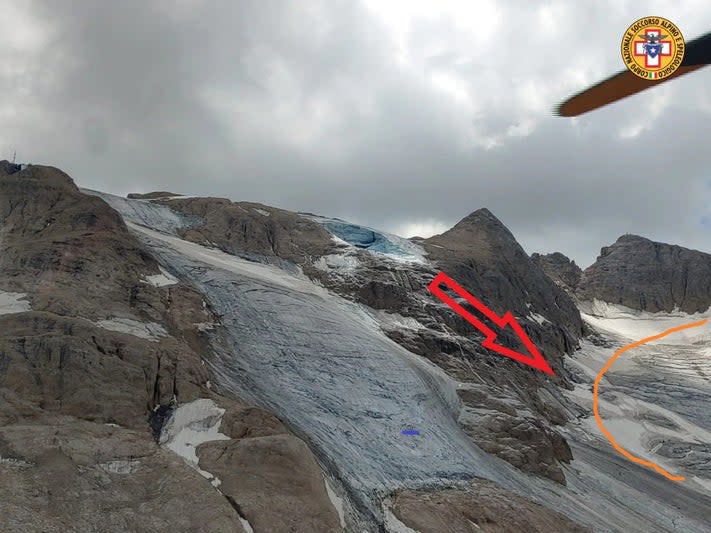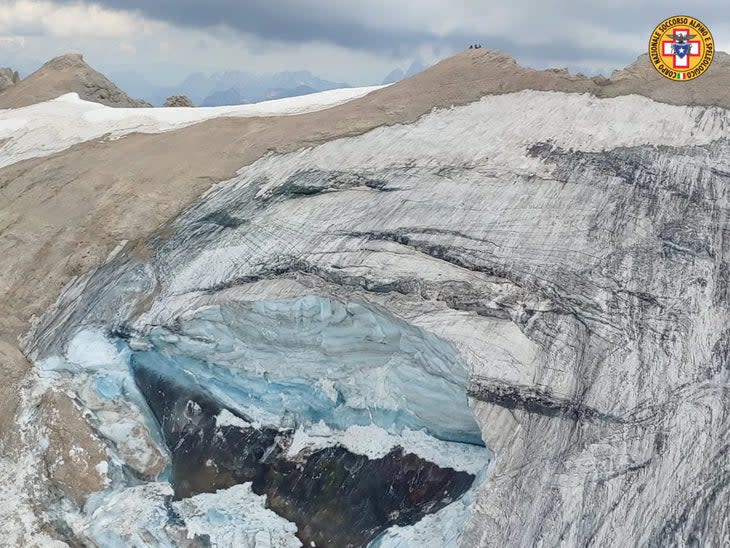Largest Glacier in Dolomites Collapses, Killing At Least Seven, Five Missing
This article originally appeared on Climbing
In the early afternoon of Sunday, July 3, a massive slab of the Marmolada Glacier detached, thundering down onto groups of climbers below. The slab was estimated to be 650 feet wide, 200 feet high, and 250 feet deep. The resulting avalanche of rock, ice, and snow reached speeds of nearly 200 mph, colliding into at least two guided rope teams. In total, seven climbers were killed in the slide and eight injured, with two of those in critical condition.
As of July 5, five individuals remain missing, and rescuers reported finding more body parts amid the debris. Not all victims have been identified, but among the dead are two local alpine guides, one of whom, 52-year-old Paolo Dani, was the former head of a local alpine-rescue chapter and a helicopter-rescue specialist.
Marmolada (10,968 feet), colloquially known as the "Queen of the Dolomites" is the highest peak in the Dolomites, and its glacier is also the range's largest. The glacier, resting at an altitude of approximately 10,500 feet, has been measured annually since 1902. Records show that it has lost 80 percent of its mass in the last 80 years, according to Riccardo Scotti, head of the Lombard Glaciological Service. A whopping 70 percent of that total glacial loss occurred in the last 20 years alone.

This significant reduction in size was also one of the reasons the Marmolada Glacier was no longer considered particularly dangerous, according to many local glaciologists. Cristian Ferrari, president of the Glaciological Commission of the Tridentine Alpinists Society (SAT), told Italian news outlet il Manifesto that the biggest risk in recent years on Marmolada has been crevasses, not avalanches. "The Marmolada is one of the most monitored, studied, and observed glaciers in the Alps," he said. "If there had been a warning, many would have reported it."
Others claim that there were audible warning signs, however, and that climbers and trekkers should've been restricted from the mountain in the days leading up to the collapse.
For starters, a significant drought stretched throughout last winter in the Dolomites, and the range saw little to no snowfall, exacerbating the already rapid glacial melt in the region. Before the incident, temperatures on the Marmolada Glacier had also remained above freezing (32 ) for 23 consecutive days, even at night (marking the first time in recorded history this occurred). Temperatures stretched as high as the mid-50s during the two weeks before the incident and were reported at 50 on the day the collapse occurred.
The steward of a local mountain hut also penned a blog shortly before the tragedy, writing that he could hear water flowing beneath the ice on the glacier (a sign meltwater had penetrated the glacial mass, furthering melt and destabilization). This theory was promoted as the most probable cause of the slide by the University of Innsbruck glaciologist Georg Kaser, among others.
The Italian Meteorological Society (SMI) supported the meltwater theory in a Facebook post, noting that although analysis was still ongoing, "The most credited hypothesis calls into effect the penetration inside the glacier mass--through a crack just below the summit--of abundant water ... generating overpressures capable of "ungluing" part of the glacier and triggering its sudden collapse."

The SMI added that the glacial collapse could not have been easily predicted, however, noting that although the glacier has degraded dramatically due to global warming, most of these potential warning signs (glacial retreat, rising temperatures, lack of snowfall, etc.) are present on countless mountains throughout the Alps (and the world), making it near impossible to identify Marmolada's glacier, in particular, as a spot of concern.
"Although in seasons like this--very hot with intense and early meltdown and deglaciation--and in the context of current global warming, [glaciers and mountains] frequently present major and known risks ... no element lets us foreshadow that right there and at that moment (compared to other glaciers in similar conditions from one end of the Alps to the other) an event of this magnitude could occur."
SAT president Ferrari's opinion was also that even if implemented, a ban on climbing wouldn't have done much to prevent the incident. "Every time an avalanche falls, people ask us: could it not be closed?" he said. "The truth is that every time we try to ban an area considered dangerous, that ban is systematically evaded. Closing the mountain, placing bans, monitoring everything is not the solution."
Like most climbs on glaciated peaks, ideally, the climbers on Marmolada would've made an alpine start (pre-dawn) and planned to be off the mountain by noon for optimal safety, said Italian climber Federico Bernardi, who also runs the news site Montagna Magica. Climbing during the sunny afternoon is never the safest bet.
"But there is no serac hanging over this route [on Marmolada]," he said, so falling seracs are not traditionally considered a risk. This collapse came instead from far above, off the summit glacier, something that would've been almost impossible to forecast.
"This tragedy could have happened at any time of day," Bernardi continued. "Things are changing so fast that it is hard to predict these things. There wasn't any alert, except for the biggest alert of all: global warming. It's affecting everything--we are losing glaciers throughout Italy."
For exclusive access to all of our fitness, gear, adventure, and travel stories, plus discounts on trips, events, and gear, sign up for Outside+ today.

